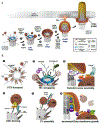Ciliogenesis membrane dynamics and organization
- PMID: 35351373
- PMCID: PMC9510604
- DOI: 10.1016/j.semcdb.2022.03.021
Ciliogenesis membrane dynamics and organization
Abstract
Ciliogenesis is a complex multistep process used to describe assembly of cilia and flagella. These organelles play essential roles in motility and signaling on the surface of cells. Cilia are built at the distal ends of centrioles through the formation of an axoneme that is surrounded by the ciliary membrane. As is the case in the biogenesis of other cellular organelles, regulators of membrane trafficking play essential roles in ciliogenesis, albeit with a unique feature that membranes are organized around microtubule-based structures. Membrane association with the distal end of the centriole is a critical initiating step for ciliogenesis. Studies of this process in different cell types suggests that a singular mechanism may not be utilized to initiate cilium assembly. In this review, we focus on recent insights into cilium biogenesis and the roles membrane trafficking regulators play in described ciliogenesis mechanisms with relevance to human disease.
Keywords: Autophagy; Ciliogenesis; Ciliopathy; Membrane trafficking; centriole; cilia.
Copyright © 2022. Published by Elsevier Ltd.
Conflict of interest statement
Declaration of Competing Interest The authors declare that they have no conflicts of interest with the contents of this article. The content is solely the responsibility of the authors and does not necessarily represent the official views of the National Institutes of Health.
Figures


Similar articles
-
CEP162 is an axoneme-recognition protein promoting ciliary transition zone assembly at the cilia base.Nat Cell Biol. 2013 Jun;15(6):591-601. doi: 10.1038/ncb2739. Epub 2013 May 5. Nat Cell Biol. 2013. PMID: 23644468 Free PMC article.
-
Human FAM154A (SAXO1) is a microtubule-stabilizing protein specific to cilia and related structures.J Cell Sci. 2015 Apr 1;128(7):1294-307. doi: 10.1242/jcs.155143. Epub 2015 Feb 11. J Cell Sci. 2015. PMID: 25673876
-
Ubiquitin-proteasome system controls ciliogenesis at the initial step of axoneme extension.Nat Commun. 2014 Oct 1;5:5081. doi: 10.1038/ncomms6081. Nat Commun. 2014. PMID: 25270598 Free PMC article.
-
The multifaceted roles of microtubule-associated proteins in the primary cilium and ciliopathies.J Cell Sci. 2023 Dec 1;136(23):jcs261148. doi: 10.1242/jcs.261148. Epub 2023 Dec 14. J Cell Sci. 2023. PMID: 38095645 Review.
-
Stages of ciliogenesis and regulation of ciliary length.Differentiation. 2012 Feb;83(2):S30-42. doi: 10.1016/j.diff.2011.11.015. Epub 2011 Dec 16. Differentiation. 2012. PMID: 22178116 Free PMC article. Review.
Cited by
-
Primary Cilia, Hypoxia, and Liver Dysfunction: A New Perspective on Biliary Atresia.Cells. 2025 Apr 15;14(8):596. doi: 10.3390/cells14080596. Cells. 2025. PMID: 40277920 Free PMC article. Review.
-
Coordination of IFT20 With Other IFT Components Is Required for Ciliogenesis.J Clin Lab Anal. 2025 May;39(9):e70000. doi: 10.1002/jcla.70000. Epub 2025 Apr 7. J Clin Lab Anal. 2025. PMID: 40192002 Free PMC article.
-
ciBAR1 loss in mice causes laterality defects, pancreatic degeneration, and altered glucose tolerance.Life Sci Alliance. 2024 Dec 2;8(2):e202402916. doi: 10.26508/lsa.202402916. Print 2025 Feb. Life Sci Alliance. 2024. PMID: 39622622 Free PMC article.
-
Neuronal guidance behaviours: the primary cilium perspective.Front Cell Dev Biol. 2025 Jun 30;13:1612555. doi: 10.3389/fcell.2025.1612555. eCollection 2025. Front Cell Dev Biol. 2025. PMID: 40661145 Free PMC article. Review.
-
Non-canonical role for the BAF complex subunit DPF3 in mitosis and ciliogenesis.J Cell Sci. 2024 May 1;137(9):jcs261744. doi: 10.1242/jcs.261744. Epub 2024 May 13. J Cell Sci. 2024. PMID: 38661008 Free PMC article.
References
Publication types
MeSH terms
Grants and funding
LinkOut - more resources
Full Text Sources
Research Materials

